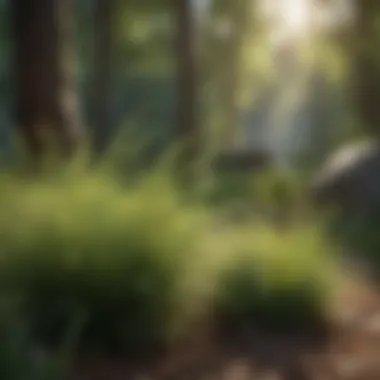Strategies for Cultivating Luxuriant Grass in Shaded Spaces


Introduction
Shaded areas can pose a challenge for grass growth due to limited sunlight exposure. This section explores effective strategies to optimize grass growth in shady environments, enhancing the appeal and vitality of your green spaces.
Understanding Shade Conditions
Before delving into specific grass types, it is crucial to comprehend the varying degrees of shade. Differentiate between light, partial, and full shade to select grass varieties best suited for the specific light conditions in your area.
Selecting the Right Grass Species
Several grass species thrive in shaded environments, such as Fine Fescue, Perennial Ryegrass, and Creeping Red Fescue. Assess the growth habits, maintenance requirements, and tolerance to shade of each species to make an informed choice.
Soil Preparation and Maintenance
Optimal soil conditions are imperative for successful grass growth. Ensure proper soil aeration, p H levels, and nutrient content tailored to the chosen grass species to promote healthy root development and overall plant vigor.
Watering and Irrigation Techniques
Efficient watering practices are essential for grass in shaded areas, as they typically receive less direct sunlight and may require adjusted watering schedules. Implement drip irrigation or soaker hoses to deliver water directly to the roots and minimize moisture loss.
Lawn Care and Management
Regular mowing, overseeding, and weed control are crucial aspects of maintaining a lush, healthy lawn in shaded locations. Adjust mowing heights, apply fertilizers strategically, and monitor for pests to ensure optimal grass growth throughout the growing season.


Conclusion
By implementing the strategies outlined in this guide, you can cultivate vibrant and resilient grass in shaded areas, transforming dull spots into lush green oases. Embrace the diversity of grass species and adapt your maintenance practices to suit the unique requirements of shaded environments.
Introduction
Growing grass in shaded areas poses a unique set of challenges that require specialized knowledge and strategies. In this article, we unravel the complexities of optimizing grass growth in shaded environments, shedding light on the nuances and considerations crucial for cultivating thriving greenery in dimly lit spaces.
Understanding the Challenge of Growing Grass in Shade
Factors Affecting Grass Growth in Shade
Growing grass in shade is impacted by various factors, such as limited sunlight, competition from surrounding plants, and soil conditions. These elements play a significant role in the development and sustenance of grass in shaded areas. Understanding the intricacies of these factors is key to successfully nurturing grass in less-than-ideal light conditions. While shade offers respite from scorching sun rays, it also presents hurdles that require careful navigation to ensure optimal grass growth.
Impact of Lack of Sunlight on Photosynthesis
The lack of sunlight in shaded areas directly affects the process of photosynthesis, which is vital for plant growth. Reduced sunlight hinders the grass's ability to produce energy, ultimately affecting its overall health and resilience. By delving into the impact of sunlight deprivation on photosynthesis, we uncover the fundamental link between light exposure and the grass's ability to thrive. This aspect underscores the critical importance of addressing sunlight-related challenges in cultivating grass in shaded environments.
Importance of Choosing the Right Grass Varieties for Shade
Shade-Tolerant Grass Species
Selecting grass species that thrive in shade is paramount for successful cultivation in such environments. Shade-tolerant grass species have evolved mechanisms to adapt to low light conditions, making them ideal choices for shaded areas. Their ability to photosynthesize efficiently without ample sunlight sets them apart, showcasing their resilience and suitability for shaded landscapes. By exploring the characteristics of shade-tolerant grass species, we uncover valuable insights into creating lush green lawns even in areas with minimal exposure to sunlight.
Adaptations for Low Light Conditions


Grass species adapted for low light conditions possess unique features that enable them to flourish in shaded environments. Their special adaptations enhance their ability to absorb available sunlight effectively while conserving energy for growth. Understanding these adaptations sheds light on the intricate ways in which plants have evolved to thrive in challenging light settings. By leveraging the adaptations tailored for low light conditions, cultivators can optimize grass growth in shaded areas, capitalizing on the innate strengths of these specialized grass varieties.
Optimal Conditions for Grass Growth
Soil Quality and Drainage Considerations
Proper soil quality and effective drainage are integral components of cultivating grass in shaded areas. The impact of soil p H on shade-tolerant grass species is substantial, as it directly influences the plant's ability to absorb nutrients and thrive under reduced sunlight conditions. By maintaining optimal soil pH levels, you can ensure that your grass varieties adapt well to shade and continue to photosynthesize efficiently. Moreover, understanding the moisture requirements for shaded areas is essential to prevent waterlogging or drought stress, which can hinder grass growth and overall health in low-light settings.
Impact of Soil p
H on Shade-Tolerant Grass The impact of soil p H on shade-tolerant grass species is a critical factor to consider when aiming to optimize grass growth in shaded areas. A specific aspect of soil pH, such as its acidity or alkalinity, can significantly influence the grass's nutrient absorption and overall vitality. Choosing grass varieties that thrive in specific pH ranges suitable for shaded environments is vital to their successful cultivation. This unique feature of soil pH adaptation in shade-tolerant grasses provides a competitive advantage by enhancing the plants' resilience and ability to flourish in low-light conditions.
Moisture Requirements for Shaded Areas
Understanding the moisture requirements for shaded areas is paramount in promoting healthy grass growth. The specific aspect of moisture management plays a crucial role in sustaining grass health and vitality in environments with limited sunlight exposure. Proper hydration levels can prevent common issues such as water stress or overwatering, which can impact the grass's resilience and overall quality. By effectively managing moisture levels, you can ensure that your shaded grass varieties receive adequate hydration to thrive and withstand shade-related challenges.
Air Circulation and Pruning Practices
Enhancing Airflow to Prevent Disease
Enhancing airflow to prevent disease in shaded areas is a proactive step towards maintaining grass health and vitality. An essential aspect of this practice involves creating an environment that facilitates airflow around the grass plants, reducing the chances of moisture buildup and fungal infections. The key characteristic of enhancing airflow lies in its ability to safeguard grass from common diseases prevalent in shaded settings, ultimately promoting robust growth and longevity. This unique feature offers a practical solution to mitigate disease risks and enhance the overall well-being of shaded grass varieties.
Recommended Pruning Techniques for Shade
Implementing recommended pruning techniques tailored for shaded areas is essential in cultivating healthy and visually appealing grass in low-light environments. A specific aspect of pruning practices involves strategic trimming to optimize light exposure and encourage dense, resilient growth in shade-adapted grass species. The key characteristic of these techniques lies in their ability to shape grass growth, promote air circulation, and prevent overcrowding, leading to healthier and more vibrant lawns in shaded settings.


Caring for Shade-Adapted Grass
Caring for Shade-Adapted Grass is a crucial aspect of this article, as it delves into the intricate details of nurturing grass in shaded environments. Understanding the nuances of caring for shade-adapted grass is imperative for individuals looking to maintain healthy and thriving greenery in low-light conditions. The section highlights the significance of tailored care techniques that address the specific requirements of grass species acclimated to shade. By focusing on proper maintenance practices, such as fertilization, watering, and pest control, readers can ensure their shaded grass areas remain vibrant and lush.
Appropriate Fertilization and Watering Regimens
Balancing Nutrient Intake in Low-Light Conditions
Effective Watering Strategies for Shaded Grass
Effective Watering Strategies for Shaded Grass are instrumental in ensuring adequate moisture levels for plants thriving in dimly lit settings. By implementing targeted watering routines that account for the reduced evaporation rates and lower light intensity in shaded areas, individuals can prevent waterlogged soil and fungal issues while promoting root growth and nutrient absorption. These strategies focus on maintaining soil moisture balance by incorporating methods like deep watering and strategic irrigation schedules, enabling grass in shaded regions to thrive despite the moisture challenges posed by reduced sunlight exposure.
Dealing with Common Shade-Related Challenges
Combatting Moss and Fungus Growth
Combatting Moss and Fungus Growth is a critical aspect of maintaining shaded grass areas free from detrimental vegetation overgrowth. Addressing moss and fungus proliferation involves implementing preventive measures such as improving air circulation, reducing excess moisture, and utilizing natural remedies like neem oil or baking soda. By proactively managing these common shade-related challenges, individuals can safeguard their grass from unsightly moss patches and fungal diseases, preserving the overall health and aesthetic appeal of their shaded landscape.
Preventing Thinning and Patchiness in Shade
Preventing Thinning and Patchiness in Shade requires a proactive approach to address factors contributing to uneven grass growth in shaded environments. This section emphasizes the importance of regular lawn maintenance practices, such as overseeding, aerating, and soil testing, to combat thinning and patchiness caused by insufficient light exposure. By promoting healthy grass density through targeted interventions, individuals can mitigate the effects of shade-induced challenges and maintain a vibrant and uniform turf appearance in shaded areas.
Conclusion
Achieving Lush Grass in Shaded Areas
Key Takeaways for Successful Grass Cultivation in Shade
Delving into the specific aspect of key takeaways for successful grass cultivation in shade, we uncover a pivotal element essential for the overall revitalization and maintenance of greenery in shaded regions. The significance of these key takeaways lies in their ability to offer invaluable insights into selecting the most appropriate grass species and maintenance practices conducive to thriving in low-light conditions. The key characteristic of these takeaways is their adaptability and resilience to challenging environments, making them a popular and beneficial choice for individuals aiming to achieve lush grass in shaded areas.
Exploring the unique feature set of these key takeaways illuminates their advantages in this article. Their ability to enhance photosynthesis efficiency and withstand shade-induced stressors demonstrates their efficacy in combating common challenges faced in shaded environments, culminating in healthy, vibrant grass growth. Such features not only contribute to the aesthetic appeal of shaded lawns but also promote a sustainable ecosystem that thrives amidst limited sunlight exposure.







